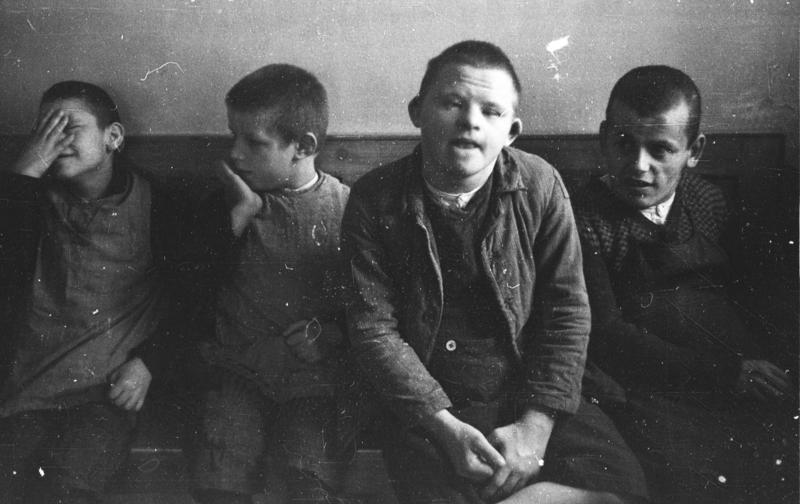Acute chorea is a movement disorder encountered primarily during childhood and having its greatest incidence between the ages of 5 and 15 years. Occurrence beyond this age is uncommon, and then is usually in association with pregnancy or in persons who have had symptoms earlier in life. Females manifest these symptoms at least twice as often as males. Acute chorea has been reported in people of all races.Considered as a symptom complex rather than as a specific disease entity, acute choreiform movements have been encountered as initial manifestations of a variety of conditions.
They have been reported in epidemic encephalitis, in the encephalopathies occurring with exanthema, with pertussis and diphtheria, in idiopathic hypocalcemia, hyperthyroidism, systemic lupus erythematosus, carbon monoxide poisoning, vascular disease, tumors, and degenerative processes of the basal ganglia. These instances, however, account for only a small percentage of cases. The closest relationship appears to be with rheumatic fever. In more than half of the cases, rheumatic manifestations consisting of carditis, valvular heart disease, or arthritis occur prior to, coincident with, or following an attack of chorea.
There are no specific pathologic changes or anatomic sites of involvement that can be correlated with acute chorea. In fact, because acute uncomplicated chorea is rarely fatal, there has been a paucity of detailed pathologic studies. Cases that have come to autopsy have shown scattered changes in the cortex, basal ganglia, cerebellum, and brainstem. These have consisted of varying degrees of arteritis combined with cellular degeneration.
The outstanding clinical features of chorea are involuntary movements, incoordination, muscle weakness, and emotional lability. Although the onset of symptoms may be abrupt and obvious, it is more often insidious and subtle. The most frequent initial complaints include clumsiness of the limbs, evidenced by dropping objects from the hands or an awkward gait, particularly during emotionally tense situations. When these are coupled with irritability, poor performance in school, and generally fidgety behavior, frequently a hasty conclusion is reached, blaming the child or implying a psychiatric disorder.
The typical choreatic movements may be noted in any part of the body, limbs, face, hands, tongue, or trunk. They may at first appear to be a part of the natural pattern of coordinated movements but are soon noted to be completely random, jerking, aimless, and purposeless. They occur at rest, are accentuated by any attempt at volitional movement, and disappear in sleep. They may be very mild and may minimally affect normal function or may be so forceful and frequent as to be totally disabling.
Facial grimacing and difficulty in speech, chewing, and swallowing occur when the muscles subserving these functions are involved. Interruption of voluntary movements by involuntary ones leads to incoordination so that the person drops objects, walks in an awkward, ungainly fashion and, in general, appears uncoordinated. Attempts to maintain forceful muscular contraction are similarly interrupted, and the resultant “waxing and waning” of motor power results in a relative degree of motor weakness. Although actual paralysis is rare, there is a disinclination to use a part of the body that is severely affected by involuntary movements of this type.
Generalized reduction of muscle tone is an invariable feature of chorea and is readily demonstrable by hyperextensibility at finger, wrist, and ankle joints. In almost all choreatic children some degree of emotional lability is evident. It varies from total apathy to irritability, restlessness, and, infrequently, wild, inappropriate behavior.
Certain cardinal features can be found in almost all patients. These include (1) pronation of the forearm when the upper limbs are raised and extended; (2) inability to sustain muscle contraction when the examiner grasps the patient’s hand or when the patient protrudes his tongue so that it darts rapidly in and out of the mouth; and (3) abnormal posturing of hands in which the wrist is noted to be sharply flexed and the fingers hyperextended at the metacarpophalangeal joints.
There are no specific laboratory tests for chorea. The cerebrospinal fluid is normal. The electroencephalogram may or may not show diffuse abnormalities correlated with the severity of the disease. Unless there are associated disease processes that manifest themselves in abnormalities of blood count, chemistry, or sedimentation rate, these studies are normal.
The age of onset and the distinctive involuntary movements readily differentiate acute chorea from other disorders of the basal ganglia. Tics and habit spasms may be confused with mild cases, but their movements are quite different, being stereotyped repetitive patterns localized to a single group of muscles. Huntington’s chorea rarely begins in childhood and, in addition, there is a strong familial tendency with associated dementia. Movement disorders associated with cerebral palsy occur in infancy but have an athetoid element. The use of phenothiazines may induce abnormal movements, but the history of drug ingestion will differentiate these.
What Is Acute Chorea,What Does It DO
Acute chorea is a self-limited disease, recovery occurring in two to six months. Recurrence, with as many as two or three attacks over a period o: years appears in almost one third of the cases. There is no specific therapy. Bed rest and reduction of external stimuli to a minimum, combined with sedative drugs such as phenobarbital or chloral hydrate, are beneficial in controlling the severity of the movements. Paradoxically, the phenothiazines, such as thorazine and chlorpromazine, as well as reserpine in doses commensurate with individual tolerance, although capable of inducing chorea, have also been shown to be effective in its control.
Because of the high incidence of rheumatic valvular heart disease complicating acute chorea, prophylaxis with antimicrobial drugs over a long interval of time similar to that utilized in acute rheumatic fever is now recommended. If emotional symptoms are intense, psychotherapy may be in order. When specific abnormalities of calcium metabolism or thyroid dysfunction are found, their correction may completely ameliorate the symptoms. With recovery most patients show few, if any, neurologic sequelae.
